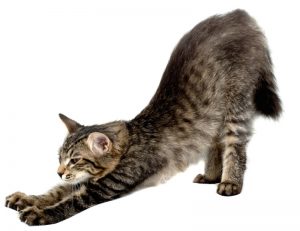Can you explain it like I’m five?
A simple explanation

When a cat wakes up, it does pleasurable yawning movements, but it’s not stretching. It is
pandiculating– tightening its muscles, and then slowly relaxing them.
We humans and need to pandiculate, too! Kids do it, but as we get older, we forget to do it. So we get stuck in 3 main patterns of tightness.
1) Going forward through life, being on the go, makes a tight, arched back.
2) Sadness and fear make the front tighten up, hunching us forward, rounding our shoulders, and making it hard to breathe.
3) When we get hurt, we hold parts still to keep them from hurting. This tightening twists us and tips us to the side, and makes things like hips and knees hurt.
Tightness that turns on again and again becomes an automatic habit, and muscles starts to hurt!
Stretching doesn’t turn off the tightness. After stretching, the brain just goes back to telling the muscles to be tight. Cats don’t do yoga to stay supple. They pandiculate. Pandiculation helps the brain realize it doesn’t have to be stuck keeping the muscle tight. Pandiculation is how to turn off your stuck patterns of tension.
The movements of Somatics help the brain remember how to pandiculate, so we can stop what is making us feel pain, and making us achy and stiff.
What a session looks like. A compilation video of session elements.
See a compilation of various session elements.
You can do this.
I’m explaining it to Fraktyl the Magical Turtle!
